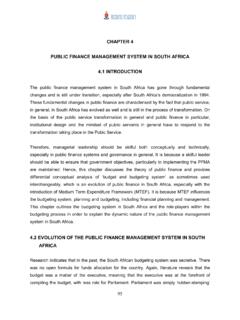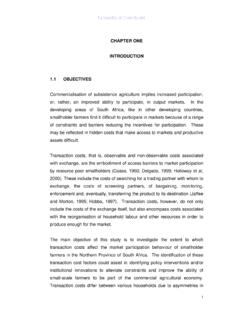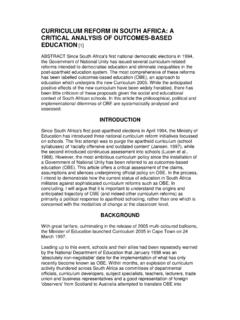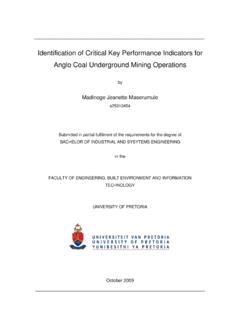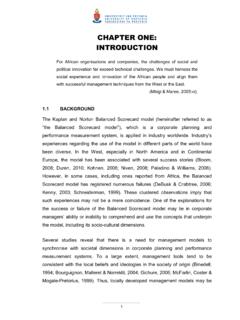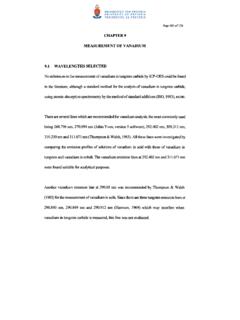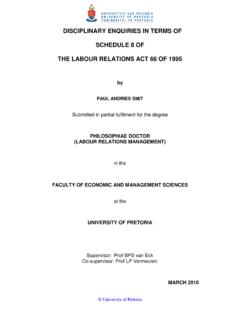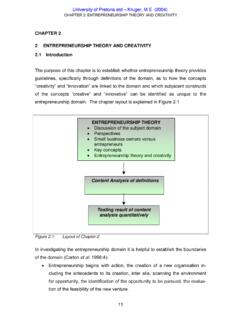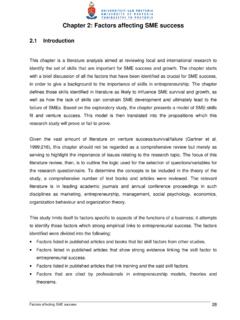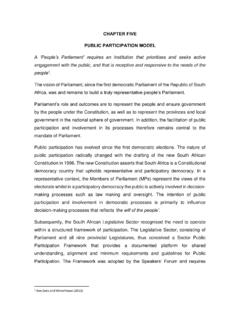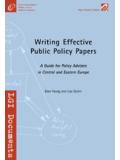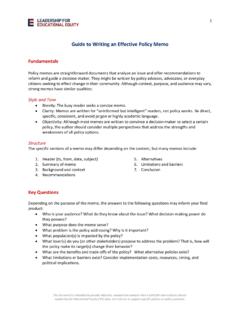Transcription of PUBLIC POLICY ANALYSIS 1. Introduction
1 86 CHAPTER FOUR PUBLIC POLICY ANALYSIS 1. Introduction Chapter three outlined what PUBLIC administration entails and factors that influenced the crafting of the assessment POLICY and how it is implemented. This chapter examines POLICY ANALYSIS and selected POLICY models. Factors that have an influence on POLICY implementation and the South African approach to POLICY formulation are described. In South Africa after 1994, a number of policies were developed that reflected the wishes of the democratic government to ensure that the needs of the communities are met. A concerted effort had to be made to stimulate PUBLIC debates and deliberations aimed at ensuring clarification of issues, models to create PUBLIC engagement and develop participation , and identification of stakeholders that play an influential role in POLICY development.
2 To implement these policies in the context of the South African PUBLIC administration environment, characterised by political, economical and cultural issues, created fundamental challenges in terms of services delivery in the PUBLIC sector, particularly in the provision of education and the curriculum to be followed. The success of any POLICY should be evaluated on its ability to address the majority of needs of the 87 intended target. Addressing the interplay between POLICY intentions and POLICY implementation will be the central theme in this chapter.
3 The chapter seeks to highlight what transpires during a POLICY process and models in the South African context. 2. POLICY statement Any democratic government cannot afford to turn a blind eye on the plight of the society it represents, Dye (1978:6). It should take measures to improve the lives of its citizens, Hanekom, Rowland and Bain (1996:25). This could be done if the government has well-defined policies pertaining to each and every aspect of its intended actions , Hanekom, Rowland and Bain (1996:6), know the resources to be used and the role-players in POLICY -making (such as the legislature; executive councils and committees; cabinet committees; internal auxiliary services and staff units).
4 It should be borne in mind that there are different levels where policies are developed. (i) The political party POLICY level: the ruling party would develop policies and get these policies implemented through government structures. In the case of education these policies and activities are directed primarily to transforming the education system and to provide effective means of improving the quality of education for all South African Constitution, (1996). 88 3. POLICY definitions There are as many definitions and explanations of the concept POLICY as there are authors, depending on the context and meaning that is conveyed.
5 Hereunder are some examples of the POLICY definitions: Richard and Baldwin (1976:122) define POLICY as formulation of rules, norms and prescriptions intended to govern the subsequent decisions and actions of government. PUBLIC POLICY is the broad framework of ideas and values within which decisions are taken and actions, or inaction, is pursued by governments in relation to some issue or problem. Brooks, (1989:16). Commitment to a course or plan of action agreed to by a group of people with the power to carry it out. Dodd and Michelle, (2000:2). A broad guide to present and future decisions, selected in light of given conditions from a number of alternatives; the actual decision or set of decisions designed to carry out the chosen course of actions; a projected program consisting of desired objectives (goal) and the means of achieving them.
6 Daneke and Steiss (1978). "proposed course of action of a person, group or government within a given environment providing obstacles and opportunities which the POLICY was proposed to utilize and overcome in an effort to reach a goal or realize an objective or purpose. Frederich, (1963:79). 89 Whatever governments choose to do or not to do. Dye, (1972: 18). Heclo (1972) in Parsons (1997:13) points that: To suggest in academic circles that there is general agreement on anything is to don crimson in the bull-pen, but POLICY is one term on which there seems to be a certain amount of definitional agreement.
7 As commonly used, the term POLICY is usually considered to apply to something bigger than particular decisions, but smaller than general social movements . Thus, POLICY , in terms of level of ANALYSIS , is a concept placed roughly in the middle range. A second and essential element in most writers use of the term is purposiveness of some kind Heclo, (1972). Hanekom (1987:7) argues that POLICY is an indication of a goal, a specific purpose, a programme of action that has been decided upon. PUBLIC POLICY is therefore a formally articulated goal that the legislator intends pursuing with society or with a societal group Hogwood and Gunn (1984: 23) define PUBLIC POLICY as.
8 A pattern of related decisions to which many circumstances and personal, group and organisational influences have contributed.. The aims or purposes underlying a POLICY are usually identifiable at a relative early stage in the process but these may change over time and, in some cases, may be defined only retrospectively. The outcome of policies requires to be studied and, where appropriate, 90 compared and contrasted with POLICY -makers For a POLICY to be regarded as PUBLIC POLICY it must, to some degree, have been generated or at least processed within the framework of governmental procedures, influences and organisations.
9 POLICY is a statement that provides a guide for decision-making by members of the organisation charged with the responsibility of operating the organisation as a system , Bates and Eldredge (1980:12). In this study, POLICY shall mean broad guidelines or statement of goals for a course of action that should be followed in an institution to address a particular problem or a set of problems in order to provide consistency in decision making. These rules, norms and prescriptions should be translated into actions that will address the needs of the intended beneficiaries and this process is referred to as POLICY implementation.
10 It could be deducted from these definitions alluded above that POLICY is aimed at something that is desired and agreed upon by a group of people with an aim to satisfy the needs of a particular group; that there should be a plan of action for implementing the intention as well as measures of evaluating the impact thereof. The people who develop this POLICY should in essence have the power to carry it out and when required, they may enforce it. In the case of PUBLIC POLICY as a sum of government activities there should be a broad framework of ideas and values within which decisions should be taken in order to maintain accountability and authenticity.
